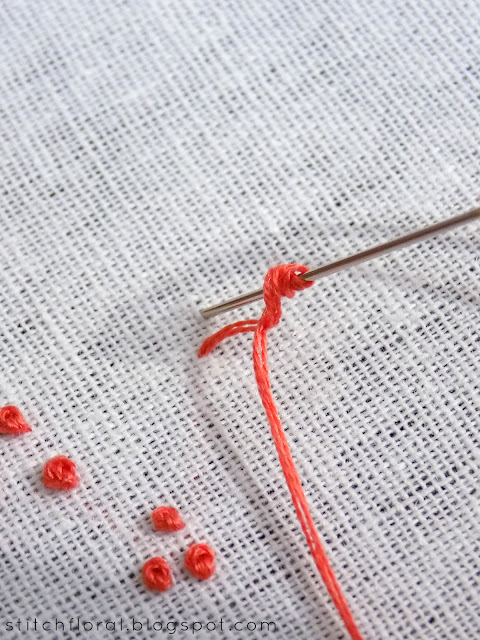I'm starting to cover the knots family of stitches and, naturally, the first post will be about the French knot. This stitch is an absolute must-have in your hand embroidery stitches range, because hardly any other stitch can compete with this one in versatility.
The number of ways you can use French knots in your hand embroidery is overwhelming! It can be a tiny berry, a tiny flower, an eye for an animal – basically, anything where you can use a dot, because that's what it is. A three-dimensional dot. In masses, these knots can be used for building up a flower (like delphinium, for example), fur, hair, flower centers and even a peculiar background. So, if you are into hand embroidery, this stitch is definitely worth your attention.
FRENCH KNOT
To work it, you need to bring your needle in the place where you want to place the knot. And wrap the thread around the needle 2-3 times. With three twists the knot will be slightly bigger. But it is not recommended to go beyond this number. 2-3 twists is the best option.
After that, pull the thread gently, so that the twists would gather together, and insert your needle in the place right next to the point where the needle emerged.
And pull the needle through, while holding gently the thread.
And this is how you get a French knot!
The steps are not difficult, however, there are some aspects a stitcher should be careful about.
First of all, the needle should have a narrow eye. Secondly, the twists should not be too tightened and too loose, otherwise, the knot might not form correctly. There should be the right balance in the tension of the thread, and it's best to find it with practice. Lastly, depending on the number of thread strands in the needle, the volume of the knot can slightly vary. To make the knot bigger, it's better to use more strands of floss in the needle, not increase the number of twists.
PISTIL STITCH
French knots have a relative – pistil stitch.
Pistil stitch is worked the same way, however, after wrapping the thread around the needle you insert it in the fabric on a certain distance from the place where it emerged the first time. This distance will decide the length of the “tail” that the pistil stitch will get.
As you may guess from the name of the stitch, it is commonly used for stitching pistils. Nonetheless, it also can be used it many other ways. For example, you can work pistil stitches in a circle and get a snowflake!
What I love most about French knot is the dimension and texture they bring to hand embroidery. These tiny dots are just so fun! I used French knots in the Winter Joy wreath as tiny blueberries and on the Boho hand embroidered baggy as a supporting motif, to balance the design.



















No comments
Write what you think! ❤
Note: Only a member of this blog may post a comment.